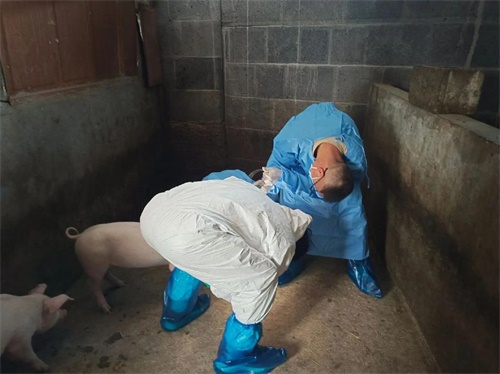Introduction: The Value of Early Detection in Veterinary Medicine
In the modern landscape of veterinary medicine, early disease detection has become an essential pillar of preventive care, both in small and large animal practice. For veterinarians, timely diagnosis not only improves treatment outcomes but also reduces overall costs, limits the spread of disease, and enhances animal welfare. Among the various diagnostic tools available today, ultrasound technology stands out as a non-invasive, real-time, and highly informative method for identifying internal abnormalities before they escalate into serious health issues.

Ultrasound has moved beyond pregnancy checks and trauma cases. Whether used in equine tendon evaluations, bovine reproductive management, or canine abdominal scans, the ability of ultrasound to reveal soft tissue, fluid accumulations, and organ irregularities without surgery has transformed the field. Dans cet article, we explore what every vet—especially those working in food-producing animal sectors—should know about using ultrasound for early disease detection, with insights drawn from global practices and recent advancements.
Understanding How Ultrasound Detects Disease
Ultrasound works by sending high-frequency sound waves into the body via a transducer. These waves bounce off tissues of varying densities, creating echo patterns that the machine interprets into real-time images. The most common imaging modality in veterinary applications is B-mode (brightness mode), which produces two-dimensional grayscale images suitable for observing anatomical structures and detecting abnormalities.
From a diagnostic standpoint, ultrasound is especially helpful in detecting:
-
Fluid accumulation (e.g., pericardial effusion, ascites)
-
Tumors or masses (e.g., splenic tumors in dogs, liver nodules in cattle)
-
Inflammatory changes (e.g., endometritis, mastitis)
-
Organ enlargement ou abnormal architecture
-
Foreign bodies in the digestive or reproductive tract
What makes ultrasound uniquely suited for early disease detection is its ability to spot subclinical or asymptomatic changes—those that aren’t visible to the naked eye or through palpation. This feature is particularly vital in food animals, where productivity losses from undiagnosed diseases can be substantial.
Small Animal Practice: Detecting Illness Before Symptoms Arise
In companion animal clinics across Europe, North America, and Australia, ultrasound is a first-line imaging tool for detecting diseases such as:
-
Kidney disease in cats, often before changes are seen in bloodwork.
-
Heart disease, through echocardiography, enabling detection of early valvular degeneration or cardiac dilatation.
-
Intestinal tumors or intussusceptions in dogs presenting with vague gastrointestinal symptoms.
-
Liver and gallbladder abnormalities, such as cholestasis or hepatomegaly, often discovered before jaundice develops.
Many vets working in urban clinics emphasize that clients are increasingly proactive and willing to authorize diagnostic imaging before symptoms worsen, especially when guided by ultrasound findings. International veterinary organizations, like the British Small Animal Veterinary Association (BSAVA), continue to promote ultrasound training for general practitioners due to its preventive care value.
Large Animal and Livestock: A Critical Tool for Economic and Welfare Decisions
Ultrasound plays an equally vital role in the livestock industry, particularly in early detection of reproductive and systemic diseases. Par exemple, uterine infections in cows or sows, if caught early via transrectal ultrasonography, can be treated before leading to infertility or systemic illness. Likewise, lung abscesses or pleural effusion in feedlot cattle can be detected using thoracic ultrasound, long before they become fatal or spread.
Case Example: Dairy Cow Reproductive Health
In modern dairy herds, ultrasound is used not only to confirm pregnancy but also to detect issues like:
-
Endometritis and pyometra in postpartum cows
-
Ovarian cysts ou anovulation, which affect estrus synchronization programs
-
Early embryonic loss, allowing rapid rebreeding
Veterinarians in countries such as the Netherlands, the U.S., and New Zealand have integrated regular ultrasound checks into herd health plans, significantly increasing conception rates and reducing days open.

How Early is “Early”? The Timeline Advantage of Ultrasound
One of the most powerful attributes of ultrasound in disease detection is the narrow window it offers between normal and abnormal. Unlike blood tests, which may only reflect pathology after organ function is impaired, or X-rays, which require structural changes to become visible, ultrasound can pick up:
-
Organ texture changes due to early fibrosis or inflammation
-
Small volume fluid shifts, signaling infection or hemorrhage
-
Subtle thickening of gastrointestinal or uterine walls
-
Changes in motility, particularly in equine or bovine gastrointestinal cases
This temporal advantage has led to widespread adoption in preventive screening protocols. Par exemple, in swine production, real-time B-mode ultrasound can identify asymptomatic uterine infections post-weaning, allowing for early culling or treatment and preventing reproductive failure in the next cycle.
Challenges and Considerations in Clinical Application
While ultrasound is an immensely useful tool, there are limitations and nuances that every vet should understand:
-
Operator dependency: The quality of interpretation largely depends on the clinician’s training and experience. Poor probe handling or misreading subtle changes can lead to misdiagnosis.
-
Limited bone and gas imaging: Ultrasound cannot penetrate bone or air, limiting its application in the lungs or skeleton unless specialized techniques are used.
-
Machine quality: Low-resolution systems may not detect early-stage changes. Devices like the BXL-V50, widely used in field practice for its waterproof design and long battery life, are favored in rural and farm environments for producing clear, detailed images of soft tissues.
To mitigate these challenges, many veterinarians engage in continuous education et tele-ultrasound consultations, where field images are reviewed by specialists remotely.
International Perspectives on Ultrasound for Disease Detection
Across continents, the veterinary community is embracing ultrasound in diverse ways:
-
États-Unis: Mobile ultrasound services are expanding, especially in large animal practices. Practices partner with portable scanning experts to detect early disease without moving animals.
-
Allemagne: Many dairy farms include reproductive ultrasound every 21 days post-calving, drastically improving herd fertility statistics.
-
Chine: Rapid growth in pig and poultry production has led to increased use of ultrasound in evaluating sows for reproductive soundness and detecting intrauterine abnormalities.
-
Africa: In wildlife medicine, ultrasound has become critical for monitoring pregnancy and health in conservation efforts, including in elephants, rhinos, and big cats.
These global practices highlight the flexibility and importance of ultrasound, regardless of geography, animal species, or clinical setting.
Building an Effective Protocol: When and How to Use Ultrasound
To get the most value out of ultrasound for early disease detection, veterinarians should implement systematic protocols:
-
Baseline Scans: Perform routine ultrasounds on high-risk animals (e.g., post-calving cows, geriatrics) even when clinically normal.
-
Condition-Specific Checklists: Use disease-specific scanning templates (e.g., uterine wall thickness, renal architecture) to ensure consistency.
-
Follow-Up Imaging: For detected abnormalities, schedule follow-up scans to monitor progression or resolution after treatment.
-
Data Integration: Combine ultrasound results with blood tests, palpation, and behavioral observation for a comprehensive diagnosis.
Using standardized documentation and image archiving also helps in long-term monitoring and case reviews.
Future Trends: IA, Portable Systems, and Wider Access
Technological advancements are quickly reshaping how veterinary ultrasound is practiced:
-
Artificial Intelligence: AI-powered systems are beginning to assist in identifying pathology, reducing the burden on less experienced vets.
-
Wireless and portable units: Devices like the BXL-V50 offer real-time imaging in field conditions, with data saving via USB or wireless transfer.
-
Affordable training: With global access to online courses and simulation tools, more vets than ever are becoming proficient in ultrasound.
As accessibility increases, early detection via ultrasound is expected to become a standard of care, not just a specialty tool.
Conclusion: A New Era of Preventive Veterinary Medicine
Ultrasound has firmly established itself as an indispensable tool in early disease detection across all areas of veterinary medicine. From spotting hidden tumors in dogs to managing fertility in dairy cows, the technology empowers vets to intervene earlier, treat more effectively, and promote better animal welfare.
As the global veterinary community moves toward data-driven, proactive healthcare, ultrasound offers the clarity and immediacy needed to detect disease before symptoms appear. With proper training, high-quality equipment, and systematic usage, every vet can use ultrasound to elevate their diagnostic capabilities—and ultimately, their quality of care.
References
-
Whitaker, D. A., & Smith, E. (2021). Veterinary Ultrasonography in Food-Producing Animals. Journal of Veterinary Imaging.
-
Beef Cattle Institute. (2023). Use of Ultrasound for Growth Evaluation in Cattle. Retrieved from: https://www.beefcattleinstitute.org/ultrasound-growth
-
British Small Animal Veterinary Association. (2022). Ultrasound Best Practices in General Practice.
-
American Association of Bovine Practitioners (AABP). (2024). Ultrasound for Reproductive and Health Management in Cattle.
-
International Pig Veterinary Society. (2023). Diagnostic Imaging for Sow Health and Productivity.